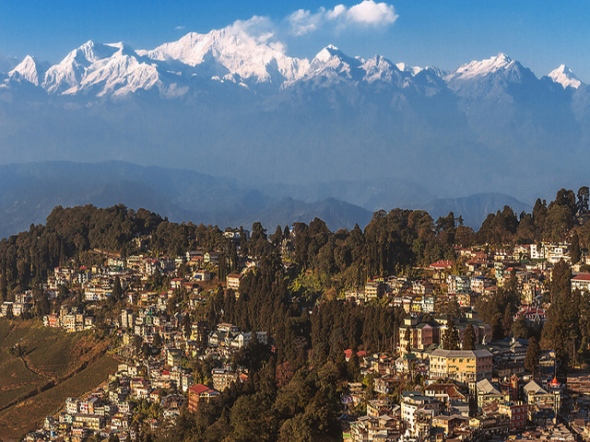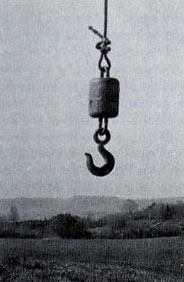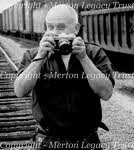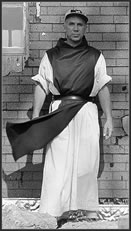Posted: May 13, 2011 | Author: roy hamric | Filed under: buddhism, people, photography | Leave a comment:
Thomas Merton named this photograph “The Sky Hook,” but he wrote,
“It is the only known picture of God.” See my essayThomas Merton: Looking
Through the Window in the On the Record listing.
The Hameric Journal. https://royhamric.wordpress.com/?s=Thomas+Merton
https://royhamric.wordpress.com/?s=Thomas+Merton
Posted: May 13, 2015 | Author: roy hamric | Filed under: articles, buddhism, Buddhism Zen, states of mind, writing |Tags: Merton on
photography, thomas merton in
Asia | 1 Comment

Mount Kangchenjunga
from Darjeeling
Thomas Merton, during his Asian pilgrimage, waited for days to see and
photograph Mount Kanchenjunga, but it was covered by clouds. His visual sense
was acute. In Conjectures of a Guilty Bystander, he wrote: “Nothing
resembles substance less than its shadow [words, drawings…]. To convey the
meaning of something substantial you have to use not a shadow but a sign, not
the imitation but the image. The image is a new and different reality, and of
course it does not convey an impression of some object, but the mind of the
subject: and that is something else again.” I discuss his pilgrimage and his
photography in an essay under “On the Record,” which is listed in the column on
the right. Merton died in Bangkok in December 1968.
Posted: May 13, 2011 | Author: roy hamric | Filed under: buddhism, people, photography | Leave a
 Thomas Merton named this photograph “The Sky
Hook,” but he wrote, “It is the only known picture of God.” See my essayThomas
Merton: Looking Through the Window in the On the Record listing.
Thomas Merton named this photograph “The Sky
Hook,” but he wrote, “It is the only known picture of God.” See my essayThomas
Merton: Looking Through the Window in the On the Record listing.
Posted: May 15, 2010 | Author: roy hamric | Filed under: articles, buddhism, people, photography | 1 Comment
This is an expanded version of an essay that appeared in The Kyoto Journal, issue
No. 47 in 2001.
The Photography of Thomas Merton: Seeing Through the Window
By Roy Hamric
Trappist Monk Thomas Merton, in his twenty-seventh year at Gethsemani
Monastery, wrote to his friend novelist John Howard Griffin, in 1968, shortly
after he received the gift of a camera: “It is fabulous. What a joy of a
thing to work with.The camera is the most eager and helpful of all
beings, all full of happy suggestions. Reminding me of things I have
overlooked and cooperating in the creation of new worlds. So Simply. This
is a Zen camera.”

merton with his Canon
And so, Merton’s life as an amateur photographer intensified. One of the
most spiritual and literary men of our times, Merton had been taking
photographs of his friends and the surroundings at Gethsemani, near Louisville,
Kentucky, for several years. He enjoyed using the clear glass of the camera
lens and the frame of the viewfinder as tools to help him see and to understand
the world. The mirror-like view of the camera, recreating whatever it is
pointed at, was perfect for Merton’s practical blend of spirituality.
His spiritual path had evolved over the years, as he began to explore
the spiritual connections with Zen, largely through the writings of D.T.
Suzuki. He longed to become more deeply involved in the “ordinary.”
merton in a baseball
cap
Many of Merton’s earliest photographs are similar in style to early
Chinese painter-calligraphers who tried to capture the direct essence of form.
Merton wrote to his friend, John C. H. Wu, the translator of one of the best
English versions of the Tao Te Ching, that he was uncomfortable with “mystical
writings.” He expressed his desire to go to Asia “to seek at the sources some
of the things I see to be so vitally important–the Zen ground of all the
dimensions of expression and mystery in the brushwork of Chinese calligraphy-
painting, poetry and so forth.”
“On the contrary,” he wrote, “it seems to me that mysticism flourishes
most purely right in the middle of the ordinary. And such mysticism, in
order to flourish, must be quite prompt to renounce all apparent claim to be
mystical at all.”
It is no surprise that a monk who lived a life sequestered from society
should be attracted to the still, and silent, photographic image. Within
that visual stillness and exchange between the seer and the seen lies a
mystery–perhaps some of the spiritual mystery of why one would become a monk in
the first place.
During the sixities, as Merton began to explore Asian philosophy, he
also began to experiment with calligraphy, creating striking images. In
1958, he wrote in his journal that he had bought a copy of “The Family of
Man,” Edward Steichen’s landmark photography book which established
the power of photography to evoke universal truths. Merton saw the images as a
form of “writing” in which “no explanations are necessary!” “How scandalized
some would be if I said that this whole book is to me a picture of Christ, and
yet that is the Truth..” This reaction to the visual came in the same entry in
his journal in which he recorded what was later to be described as his
“Louisville epiphany,” wherein he wrote that he had experienced an
overwhelming sense of “oneness” with other people on a street corner.
John Howard Griffin, the author of the civil rights classic Black
Like Me, was also an amateur photographer. In 1963, he wanted to
build a photographic archive of Merton and his life at Gethsmeni. He wrote to
Merton mentioning his desire, and he visited him a short while later. While
there, he said, “Tom watched with interest and wanted an explanation of the
cameras––a Leica and Alpha.” Merton told Griffin, “I don’t know anything about
photography, but it fascinates me.”
Merton had begun his first serious exploration of photography when in
January 1962, he visited a Shaker village near the monastery. He found “some
marvelous subjects,” he wrote in his journal, and his description of what he
saw and photographed signaled that his search for subjects was part of a highly
developed visual acuity that unfolded in a charged contemplative state of mind
: “Marvelous, silent, vast spaces around the old buildings.” he wrote in his
journal. “Cold, pure light, and some grand trees…. How the blank side of a
frame house can be so completely beautiful I cannot imagine. A completely
miraculous achievement of forms.”
Merton and Griffin started a spiritual-literary friendship during a
retreat Griffin made at Gethsemani. Griffin sensed that Merton’s mind innately
took to the camera’s frame. He served as a constant source of
encouragement to Merton, volunteered to process Merton’s film and became a
casual critic of his contact sheets.
They exchanged regular letters touching on Merton’s photography from
1965 through 1968–the year of Merton’s accidental death in Bangkok, following
his epiphanic tour of Asia. Merton’s Asian journal of his
pilgrimage, and the inclusion of about 30 photographs that he took during the
trip, were published as The Asian Journal of Thomas Merton–a work
unlike Merton’s other books in its personal intensity. Upon finishing the book,
you have a sense that Merton’s life was in a profound stage of evolution.
That revelation, for me, comes through most strongly in the journal
entries chronicling the things he photographed during his journey.
But his earlier photographs also offer tantalizing clues to Merton’s
spiritual journey in his final years.
By 1964, Merton had regular access to a camera and his reading of Zen
books became an integral part of his life, no doubt stimulating his interest in
the visual experience itself through its emphasis on “attention” and
“experiencing the moment.” On September 24, Merton linked Zen and photography
in another journal entry: “After dinner I was distracted by the dream camera,
and instead of seriously reading the Zen anthology I got from the Louisville
Library, kept seeing curious things to shoot, especially a window in the tool
room of the woodshed. The whole place is full of fantastic and strange
subjects––a mine of Zen photography.”
In the following years, he moved on to better cameras, eventually
gaining access to a Rollieflex owned by the monastery. When it
malfunctioned in 1968, he immediately wrote to Griffin, who sent him a 35mm
Canon FX with 50 mm and 100 mm lenses.
The new camera was the springboard to more sophisticated pictures, and
Merton was soon comparing notes with Griffin on the ins-and-outs of
photography. He never took any interest in developing his own film or printing
his images, instead sending exposed rolls of film to Griffin, who with his son,
Gregory, developed the film and sent back contact prints for Merton to select
the images he wanted printed. Griffin recalls that he and his son were often
frustrated that Merton seemingly skipped over “superlative” images and instead
marked others that seemed ordinary to them.
“He went right on marking what he wanted rather than what we thought he
should want,” recalled Griffin. “ Then, as he keep taking photographs, more and
more often he would send a contact sheet with a frame marked and an excited
notation: ‘At last––this is what I have been aiming for.”
Griffin soon began to appreciate Merton’s personal visual quest: “He
focused on the images in his contemplation, as they were and not as he wanted
them to be. He took his camera on his walks and, with his special way of
seeing, photographed what moved or excited him––whatsoever responded to that
inner orientation.”
Merton’s interest in painting and photography had taken a decisive turn
in early 1965, after he read “The Tao of Painting” by Mai-Mai Sze, a
work he called “deep and contemplative.” He began practicing Chinese
brushstrokes in a freehand style, one of which he published on the cover
of Raids on the Unspeakable. In August of that year, he
moved to a cottage hermitage surrounded by woods on the grounds of Gethsemani
where he found more solitude and where nature increased his awareness of flora
and fauna. Writing in his journal of his early days at the hermitage, he said
the hermitage lifestyle challenged him “to see the great seriousness of what I
am about to do.”
“Contrary to all that is said about it,” he wrote, “I do not see how the
really solitary life can tolerate illusion or self-deception. It seems to
me that solitude rips off all the masks and all the disguises. It
tolerates no lies. Everything but straight and direct affirmation, or silence,
is mocked and judged by the silence of the forest.”
Merton’s natural visual acuteness was intensified during his walks
through the fields and woods at his monastery. As a band of deer appeared from
out of the woods one day, he watched silently:
“I watched their beautiful running, their grazing,” he wrote in his
journal. “Every movement was completely lovely, but there is a kind of
gaucheness about them sometimes that makes them even lovelier, like girls. The
thing that struck me most–when you look at them directly and in movement–you
see what the primitive cave painters saw. Something you never see in a
photograph. It is most awe-inspiring. The ‘spirit’ is shown in the
running of the deer. The deerness that sums up everything and is sacred
and marvelous.”
Merton described such deep perceptions as “contemplative intuition, yet
this is perfectly ordinary, everyday seeing–what everybody ought to see all the
time.”
“The deer reveals to me something essential, not only in itself, but also
in myself,” he wrote. “Something beyond the trivialities of my everyday
being, my individual existence. Something profound. The face of that
which is both in the deer and in myself.”

thomas merton
Whenever Griffin visited Merton, the two men often took long walks in
the woods and surrounding countryside looking for objects and scenes to
photograph. A letter dated Dec. 12, 1966, refers to pictures Merton took of
tree roots. “I signed them as you requested, and have sent back the ones you
want,” he wrote to Griffin. “They are really splendid. I find myself
wondering if I took such pictures.”
His life at Gethsemani was isolated, yet he became friends with another
most unusual photographer, Ralph Eugene Meatyard, who had photographed Merton
and who lived in Louisville. Meatyard had already achieved great recognition as
an exceptionally original and brilliant photographer. He was also interested in
Zen, and he took many mysterious, haunting photographs of Merton. They
exchanged 16 letters. Meatyard was not, unlike most people, awed by Merton’s
reputation, and he seemed to see the man whole: “[I was] photographing a
Kierkegaard who was a fan of Mad [magazine]; a Zen adept and hermit who droooled
over hospital nurses with a cute behind…a man of accomplished self-descipline
who sometimes acted like a 10 year old with an unlimited charge account at a
candy store.”
One of Merton’s most
personal photographs from that period is called “The Sky Hook.” He wrote
that the picture “is the only known photograph of God.” The picture’s
composition is balanced between material and non-material space, cut through
the center from the top by a steel hook, curled toward the sky–empty–holding
nothing.



